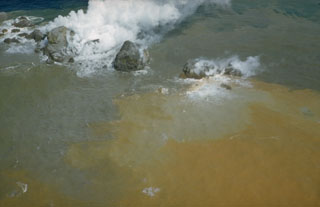Report on Myojinsho (Japan) — 25 January-31 January 2023
Smithsonian Institution / US Geological Survey
Weekly Volcanic Activity Report, 25 January-31 January 2023
Managing Editor: Sally Sennert.
Please cite this report as:
Global Volcanism Program, 2023. Report on Myojinsho (Japan) (Sennert, S, ed.). Weekly Volcanic Activity Report, 25 January-31 January 2023. Smithsonian Institution and US Geological Survey.
Myojinsho
Japan
31.888°N, 139.918°E; summit elev. 11 m
All times are local (unless otherwise noted)
According to JMA an area of pale yellow-green discolored water with a diameter of about 100 m was visible about 65 km SSE of Myojinsho on 26 January, based on an overflight conducted by the Japan Coast Guard. An eruption warning was issued to mariners. Discolored water was last observed in March 2018.
Geological Summary. Beyonesu Rocks are part of the barely exposed rim of the largely submarine Myojinsho caldera. Formation of the 8-9 km wide caldera was followed by construction of a large (2.6 km3) lava dome and/or lava flow complex on the caldera floor, originally located at a depth of 1,000-1,100 m. Most eruptions recorded since the late-19th century have occurred from the dacitic post-caldera Myojinsho lava dome on the NE caldera rim. Deposits from submarine pyroclastic flows associated with growth of the dome cover it and extend both into the NE part of the caldera and down its outer slopes. An explosive submarine eruption from Myojinsho in 1952 destroyed a Japanese research vessel, killing all 31 on board. Submarine eruptions have also been observed from other points on the caldera rim and outside of the caldera. The Beyonesu Rocks were named after the French warship the Bayonnaise, which was surveying volcanic islands south of Tokyo Bay in 1850.
Sources: Japan Meteorological Agency (JMA), Japan Coast Guard

